The ground in your fields is a precious asset which must be preserved and maintained to obtain the best possible yield. With this objective, it is relatively easy to understand that you cannot invest in regular inputs to improve your yield, then damage your soil through excessive compaction, so it is reasonable to think that the tyre, which is your principal contact with the ground, is one of the key elements which has the power to improve or reduce your productivity.
Surely you have already noticed how difficult it is to get any work done when you spend your time slipping...
Maybe you also wondered why your yields have diminished year after year in the same plot of land?
Or even: why is there excessive water pooling on the surface rather than seeping into the ground, etc.
These are all problems that you can limit by working with more high-tech equipment that has been studied and developed to improve your productivity.
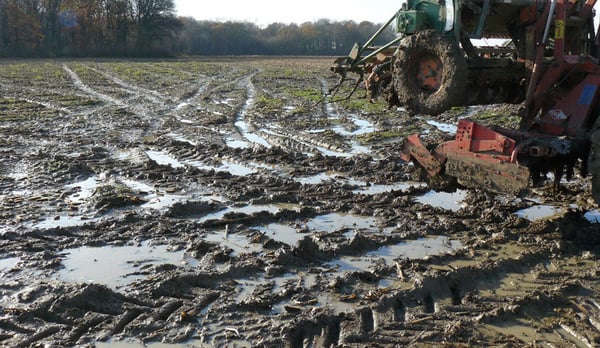
Here are the key points linked to your tyres that must take into account to improve your yields:
1. What type of tyre structure will give me the best yields?
There are two different types of agricultural tyre structure:
- Radial: is more suitable for work in the fields and use on the road.
- Bias ply: is an older design which is intended more for work in the farm courtyard due to its firmer structure.
What is a radial tyre?
In the agricultural world, the radial tyre is now the most widely used at the expense of the bias ply tyre. Radial tyres are composed of transverse woven cord plies which constitute the first layer of the structure and run at 90 degrees to the direction of travel.
This basic structure is reinforced over the entire width of the tread by cross-stabilising plies whose number increases or decreases in line with the quality of the tyre. In addition to being more resistant at the level of the tread, the radial tyre offers better transfer of power to the ground which optimises motricity, while limiting soil compaction.
It has better shock absorption capacities and is excellent for road handling, because the sidewalls are more supple and have better deflection characteristics which allow them to adapt to the ground, thus providing optimal driving comfort.
What are the particularities of the bias ply tyre?
The bias ply tyre is also made up of layers of cross-ply cords. These layers extend diagonally from bead to bead under certain angles.
The thickness and number of plies in the sidewalls are therefore identical over the entire surface of the tyre, which makes it rigid and apt to cope optimally with solicitations such as: traction, soil preservation, agility on the road, etc.
Due to its simpler construction, the bias ply tyre tends to be less expensive generally, its resistance is consistent and highly dependent on the number of overlapping plies; the more there are, the more rigid and hard the structure is, which is the case for forestry or industrial tyres.
How to choose between radial and bias ply tyres?
The specific structure and composition of the radial agricultural tyre provides a combination of rigidity and strong resistance at the level of the tread, with elasticity in the sidewalls. Unlike the bias ply tyre, the radial structure gives you a greater contact patch with the ground, which limits soil compaction given that it provides a more even distribution of the load and optimal driving comfort for the farmer.
For the bias ply tyre, the distribution of pressure to the ground is not even, which leads to a major compression area at the centre of the tread and thus greater soil compaction with the same inflation pressure. This type of tyre is not recommended for work in the fields, because pressure to the ground is higher which can be harmful to soil and crops.
2. How do I improve my traction capacity to save time?
The principal element involved in the transmission of traction capacity from your tractor to the ground is your tyre. It is with this in mind that you must choose your tyre with the utmost care, depending on the type of ground on which you intend to work. By opting for well-adapted tyres, you can increase the traction capacity of your vehicle considerably.
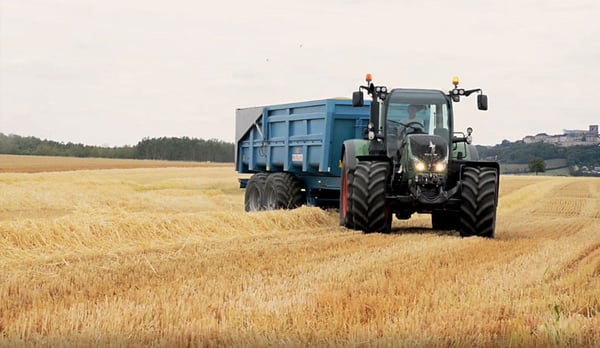
The question is which type of tyre to choose. Among the current solutions, the use of a low pressure IF (Improved Flexion) tyre is effective in optimising the pulling power of your tractor. Equipped with supple sidewalls, this new generation tyre has a bigger footprint on the ground, making it possible to increase the contact with the lugs which are responsible for the transmission of tractive force.
Opting for a high-volume, low-pressure agricultural tyre allows you to optimise tractive power during ploughing work for example.
As the tyre’s contact with the ground is better, you reduce the working tyre slip percentage and as such you automatically reduce fuel consumption while improving performance, which should lead to much better yields.
3. Which tyres will preserve my soils best?
A quality soil is a complex mixture of organic materials and minerals, biological life, air and water in more or less significant quantity.
A plant’s capacity to develop and turn into a quality crop depends directly on the quality of this soil.
The use of unsuitable tyres will result in progressive and insidious compaction of the soil, leading to indirect problems that you will not necessarily associate with soil compaction. For example, you may encounter:
- Run-off problems and soil erosion which are directly linked to the compaction which blocks water infiltration in the deep soil layers.
- Loss of efficiency of your inputs which are leached from the soil as soon as it rains, obliging you to increase the quantity of inputs to obtain good results.
Choosing the right tyre helps to reduce the compaction and thus preserve your soils better.
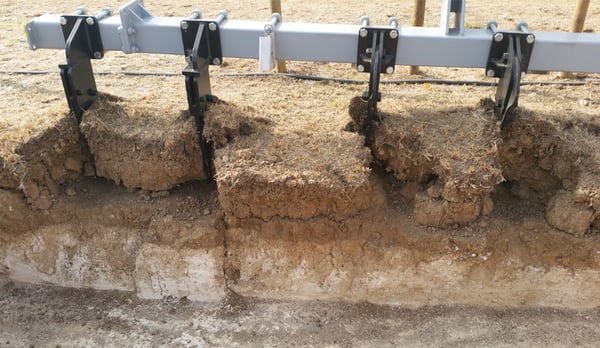
Opting for low-pressure IF tyres such as the Maxi Traction IF allow you to work at the very low pressure of 0.6 bar. As opposed to standard tyres or bias ply tyres which require high pressure to bear the load, IF technology agricultural tyres have a supple but reinforced sidewall structure which allows them to work at a very low inflation pressure.
Given that the weight is distributed over a large surface area on the ground: +40% at a pressure of 0.6 bar, soil compaction is considerably reduced as you can see from the following diagram.
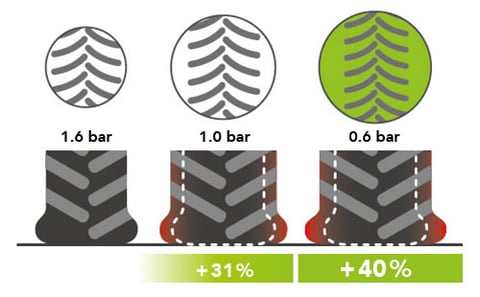
Low pressure Maxi Traction IF tyres have a Dual Angle lug design which has been studied to obtain a tread design that limits soil disturbance and, combined with use at low pressure, preserves the root system of the plants to obtain optimal development.
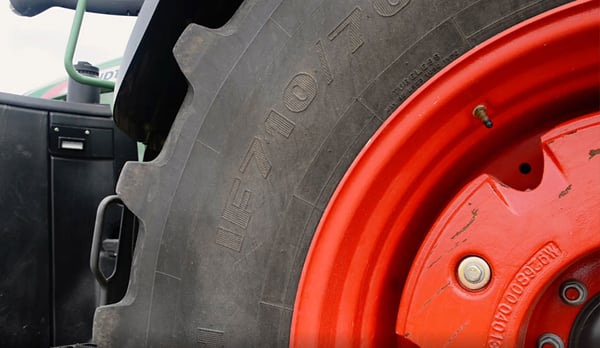
Even if the acquisition of a new IF agricultural tyre may seem like a major investment, you must do everything you can to safeguard your most important asset: YOUR LAND. Such a decision will have nothing but positive impacts on your yields and will allow you to obtain good quality harvests on a regular basis.
4. Is it possible not to have to adjust tyre pressure between fields and road to save time?
If you use standard agricultural tyres you will need to adjust tyre pressure between the field and the road, yet this operation represents a significant waste of time for the farmer. Tyre pressure must be adapted to several factors, including:
- The load
- The speed
- The condition of wear of the tyre
- The type of ground: earth, road…
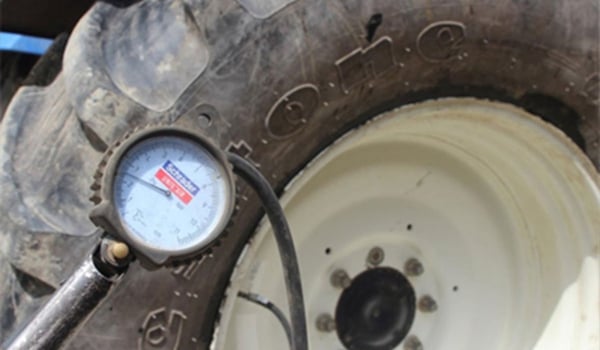
Depending on whether inflation pressure is too high or too low, the consequences will be very different:
- If your tyre pressure is too low: the tyre will tend to squash excessively into the ground, which triggers a weakening at the centre of the tread as well as abnormal wear to the lugs and shoulders. On the road, underinflation leads, maybe among other phenomena, to a heating of the tyre structure constituents which inevitably causes a separation of the nylon elements and rubber components. While reducing tyre pressure is an interesting solution for soil preservation in the fields, if you drive on the roads with an underinflated tyre, you should expect premature wear to the internal structure of the agricultural tyre.
- If your tyre pressure is too high: ou reduce your tyre footprint while considerably increasing the effect of soil compaction. On the road, overinflation reduces the contact patch with the ground and the surface that absorbs vibration. This may accentuate wear to the tread in the centre, leading to poor road handling. Driving with overinflated tyres at high speed increases the risk of loss of grip and veering off the road.
Today, there are interesting alternatives to avoid having to adapt tyre pressure every time you go from field to road, the most noteworthy being high-tech IF agricultural tyres.
These new generation tyres were designed with reinforced sidewalls which allow you to work in the fields at a pressure of 1 bar for example and to complete the journey home on the road while maintaining the same inflation pressure to avoid getting out of the tractor to adjust the tyre settings.
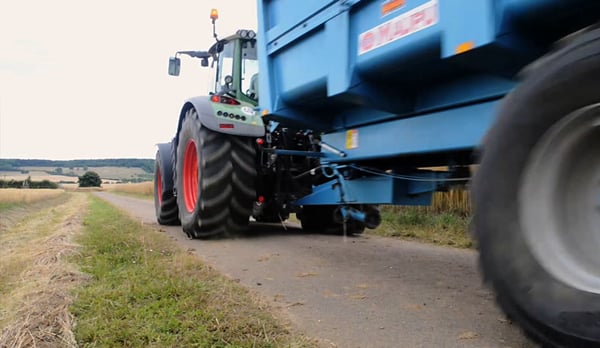
IF tyres have reinforced casing with supple more resistant sidewalls. The structure of the tread and lug design have been developed to ensure better grip to the ground. Unlike standard tyres, IF agricultural tyre pressure can be reduced to enlarge the contact patch with the ground providing better load distribution without affecting the tyre’s capacities:
- An IF tyre may be used at a pressure as low 0.6 bar, the optimal pressure being 0.8 bar, compared to 1.6 bar for a standard tyre
- It guarantees an optimal slippage rate of between 11% and 15%
- This category of tyre can carry up to 20% more load compared to a standard tyre. To be more precise, it’s 17% at 50 km/h at 1.6 bar and 16% at 50 km/h at 0.8 bar. With a maximum speed of 30 km/h, there is a gain of 13% at 0.8 bar.
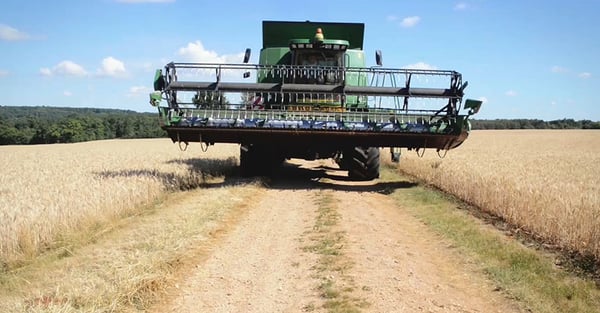
These advantages are all factors which can improve your productivity and increase your yields. Due to its direct contact with the ground, the quality of the tyre plays an important role in improving your results and in the preservation of your soil and crops.
For more information on tractor tyres
With Firestone, you have the guarantee of tractor tyres that deliver a real advantage, and that in choosing our brand, you can work worry-free.
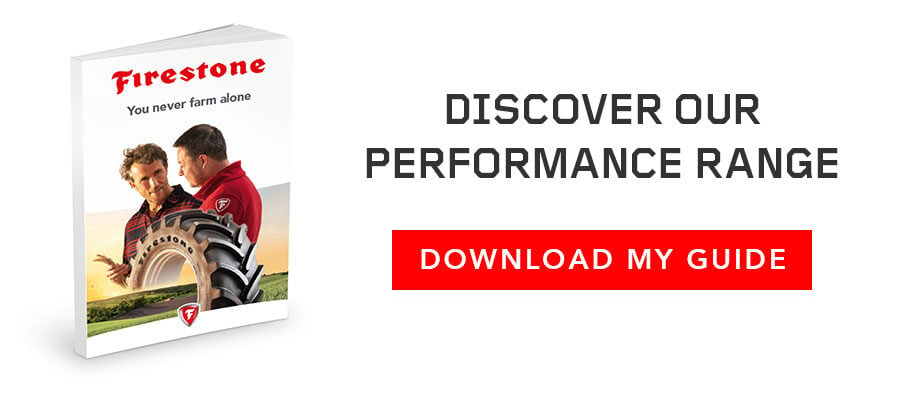
Most people who read this article have also read some of the following articles:
This information is intended only to make you aware of the technical and functional aspects of agricultural tires and their use. It does not allow you to make a judgment or a definitive conclusion on a given problem. Only your agricultural tire expert is able to make a technical assessment and take a final decision, case by case.